First Floods, Now Fires: How Neglect and Fraud Hobbled an Alabama Town
PRICHARD, Ala.—Sometimes it’s the water that plagues them. Other times, it’s the fire.
Da’Cino Dees has waded through the water in the Alabama Village neighborhood nearly all his life. Now 31, Dees said he often walked to school through the floodwater as a child. Rainwater, he said, has always stood in the streets.
“When it rains, you can’t come outside,” Dees said. “Water be up to your porch.”
Years later, on this Sunday September morning, Dees said the situation has now become desperate. There have always been the floods, he explained, and now, there are the fires, and when the fires come, there’s little that can be done.
“Everybody knows,” he said. “If something catches on fire, it’s over with.”

The community’s twin afflictions of fire and water are deeply connected.
In Prichard, a majority-Black city, decades-long deterioration of the water distribution infrastructure has led to a crisis impacting nearly every aspect of residents’ lives. Each month, nearly 60 percent of the freshwater purchased by the city is lost, according to state estimates, much of it simply leaking out of decaying water lines.
We’re hiring!
Please take a look at the new openings in our newsroom.
See jobsAs a result, residents are forced to cope with increasing bills, unreliable water service, flooding worsened by climate change and an overwhelmed drainage system and fires that sometimes blaze while firefighters watch, unable to intervene because of low water pressure and sometimes-faulty fire hydrants.
In Alabama Village, the situation is even more dire. Residents already experiencing increasing poverty and gun violence have found themselves in a neighborhood on the brink of collapse. City services are virtually nonexistent, residents said, and the water company has issued a moratorium on new accounts. Those who remain in the neighborhood, many of whom have lived there their entire lives, are worried they’ll soon be forced from their homes.
As Prichard’s water infrastructure has decayed beneath its citizens’ feet, officials have known for decades that serious issues existed and have done little to address them. Instead, the water utility—a quasi-governmental organization—has spiraled into financial insolvency and seen the indictment of its operations manager on theft charges involving using a company card to make thousands of dollars in purchases of items from Victoria’s Secret, Louis Vuitton and other designers.
Now, as the utility battles both its debtors and customers in court, people like Dees face an uncertain future. But the neglect and corruption that led to Prichard’s plagues are not the fault of the people who live there, Dees said, and they shouldn’t be punished for it.
“It ain’t our fault,” Dees said. “But Alabama Village needs help.”
A Neighborhood Fades Away
Maps won’t help you navigate Alabama Village. The roads they show are only memories.
Prichard, the Mobile suburb where Alabama Village is located, has seen its ups and downs.
Early on, its inhabitants included survivors of the Clotilda, the last known slave ship to enter the United States in 1860.
Alabama Village itself was built as World War II began to unfold — hastily constructed, modest housing for shipbuilders in and around Mobile, about five miles south, working to support the wartime production effort.
Prichard was formally incorporated in 1925, and in the decades that followed, industrial development fueled growth in the city.
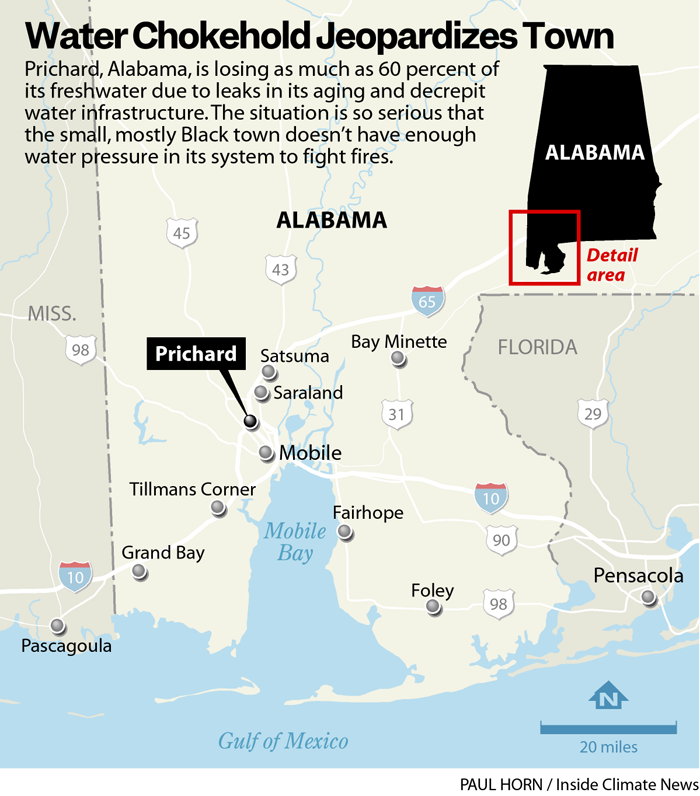
By 1960, Prichard’s majority white population peaked at around 47,000. But in the years that followed, disinvestment born of white flight left the city just a shadow of its former self.
As time passed, poverty began to choke the community and those who lived in it. Sixty years later, Prichard’s population is majority Black and numbers around 19,000.
Today, trees and brush grow in the middle of impassable roads in Alabama Village. Nestled between Mobile and its suburbs, what was once a typical Southern neighborhood has now become an undeniable example of neglect and decay.
But it’s here, Dees said, that he’s most at home. He sat on the front porch of Light of the Village, a local ministry, as he explained the feeling.
“It’s good people here in the village,” Dees said. “There really is.”
Dees had just finished serving breakfast to his neighbors at Light of the Village. Betty Catlin, who helped raise Dees, fried sausage and made grits while Dees mixed up a batch of lemonade.
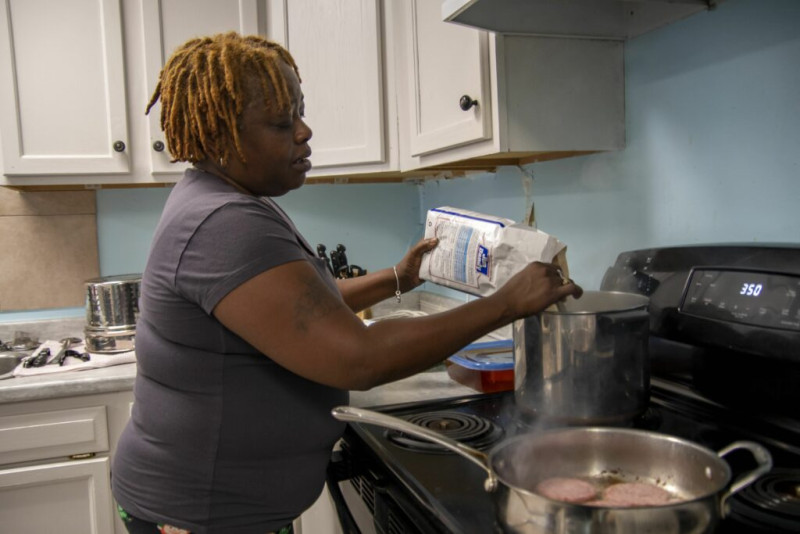
John Eads, who founded Light of the Village with his wife Delores more than two decades ago, pointed to a picture of Dees on the wall. Dees is more than two feet shorter in the photo, sandwiched between a half dozen other children, as well as Eads and his wife.
Eads helped found the ministry in Alabama Village after serving in the Army in the 1980s and ‘90s and working as a hospital administrator in Mobile. He’s been a part of the community since then, watching kids like Dees grow from boys to men.
In the meantime, though, Eads has watched as the quality of life in Alabama Village has declined.
On this Sunday, he walked over to a corner of the room the ministry uses for worship.
“This is the memorial wall,” he explained.
Displayed in neat rows were the faces of late Alabama Villagers, most of whom died as a result of gun violence. During the service that day, Eads explained, family members and friends would be adding three more of their loved ones to the wall.
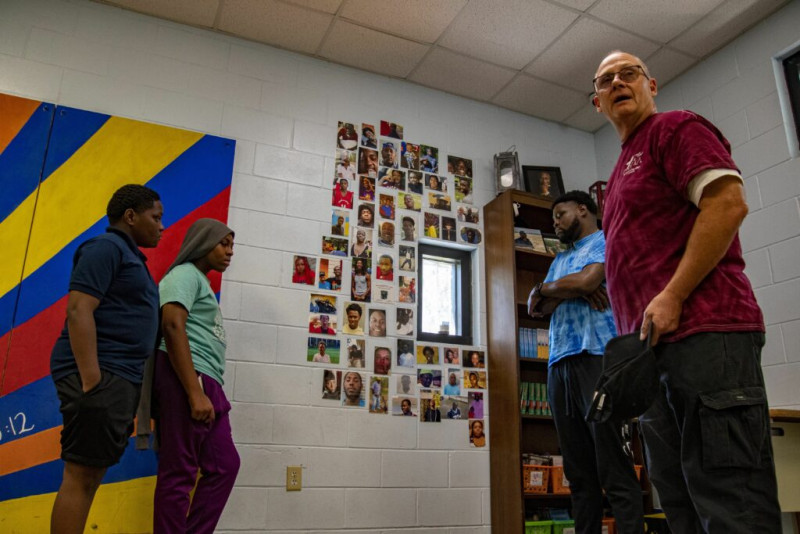
As he spoke, a young girl walked up and pointed to a picture on the wall.
It was her father.
Then she pointed to another picture.
“That’s my papa,” she said.
Then another. “And that’s my auntie.”

With daily life so full of pain and trauma, Eads said, dealing with the water issues is an unnecessary, added challenge for people who are already coping with life the best they know how.
Betty Catlin and Da’Cino Dees know how to cope. They’ve done it for decades.
But the pair seemed hopeless about the future of their neighborhood. The decades of neglect that left Alabama Village where it is, they said, have felt as if they’re by design.
“The city and the water people think the less they do, the more people will move out,” Catlin said. “They want us to fade away.”
Of Water and Fire
Every month, most of Prichard’s water is wasted. Even before a drop of water reaches a sink faucet or water hose at a home or business, more than half of the water purchased for citizens’ use has been lost.
In December 2022, for example, Prichard purchased about 123 million gallons of water from neighboring Mobile, according to public documents. The same month, 59 percent of that water—nearly 73 million gallons of freshwater paid for and piped in—was lost, primarily due to leakage caused by deteriorating infrastructure, according to a report issued in February by the Alabama Department of Environmental Management (ADEM).
At current water purchasing rates, which have increased significantly over time, that amount of water loss costs around $2.7 million each year, the state regulatory agency estimated.
While reporting standards on lost water, sometimes called non-revenue, aren’t entirely uniform, a 2006 World Bank report estimated that countries in so-called “developed” countries like the United States lose around 15 percent of supplied water on average. Countries labeled “developing” lost around 35 percent of supplied water on average. Prichard’s water loss, by comparison, is approaching 60 percent.
Data suggests the problem in Alabama Village may be even worse. Each month in Alabama Village alone, around a million gallons of water purchased for use by homes and businesses is leaking out of decaying pipes and migrating back to a sewage lift station, where it’s then pumped to a wastewater treatment plant, according to a former manager for Prichard Water.
Customers pay for the water when it enters the system, pay to pump that already-cleaned water to the treatment facility, then pay the cost of cleaning it again, the February 2023 report pointed out.
“He calculated that the combined electrical energy cost to run this pump (which reportedly operates 12 hours per day) plus the combined monthly rental cost for the pump is $250 per day. This amounts to $7,500 per month or $91,000 per year,” the ADEM report said of the manager’s conclusions.
But the impacts of Prichard’s decaying water system go far beyond economics, the report said.
The leaking, for example, impacts the city’s ability to drain rainwater. If sewers are full of clean water that’s been leaked into the system, there is less room for the rainwater the pipes are actually designed to carry.
In its report, ADEM noted “significant water ponding” in Alabama Village in various locations, including “the entire length” of one street.
Catlin phrased it more starkly.
“If it rains, you’re stuck,” she said.
Greg Varner, a Mobile lawyer who represents residents and businesses across Prichard in litigation against the city’s water utility, said that he is also worried about how a changing climate will impact residents.
“It’s all tied together,” he said. “If this problem isn’t fixed now, things are only going to compound with climate change. If you keep kicking the can down the road, it’s going to get to the point that nothing can be done.”
The water issues in Prichard, particularly in Alabama Village, amount to a hazard to public health, ADEM’s report concluded.
“The state of disrepair of Prichard Water’s infrastructure is evident and requires resolution,” the report said. “With such infrastructure conditions, providing reliable water service remains challenging. There is a significant potential for unacceptably low public water system pressure, a matter that warrants expedited attention for the protection of public health.”
Testing for residual chlorine in Prichard’s water has also shown significantly lower levels of the disinfectant than is required by state regulations.
“Perhaps due to the excessive water leaks and deteriorating overall infrastructure, it appears that the residual free chlorine provided in the supply water…may presently be insufficient to reliably provide suitable disinfection for Prichard Water customers,” the report concluded.
In some communities in Prichard, including Alabama Village, fire protection has also been stifled by low and unreliable water pressure.
“It is unlikely that suitable fire suppression water can presently be provided in this area of Prichard via these hydrants,” ADEM’s report said. “Furthermore, if anyone opened a hydrant, the likelihood of a notable drop in system water pressure in the vicinity would be significant.”
In 2018, well over 90 percent of fire hydrants failed a court-ordered inspection, according to local media reports.
Just months later, firefighters watched as a home burned, unable to intervene because of low pressure at a nearby fire hydrant. The home was a total loss.
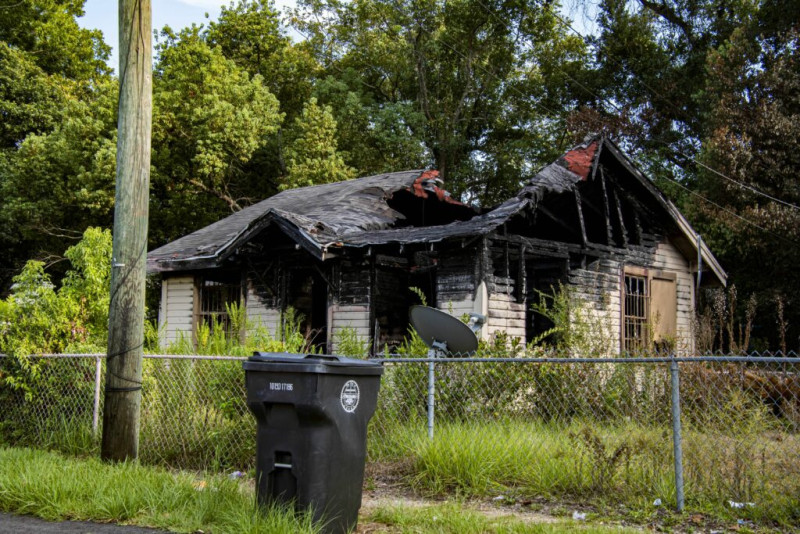
In March, a Prichard grandmother lost her home after witnesses told local media outlets that firefighters couldn’t get adequate water pressure from a hydrant.
“As soon as the fire department pulled up, it’s like five of them when they got off the truck,” said Tekeila Davis, her granddaughter. “I’m trying to see what’s going on, because I know I’m supposed to see water flying everywhere at this point. But one guy, he was like, ‘We’re not getting water.’”
From Leaks to Louis Vuitton
Prichard’s water woes didn’t occur overnight.
Varner, the residents’ lawyer, said that the condition of the water infrastructure is the result of decades of neglect and mismanagement.
Prichard water officials, Varner said, have known about water infrastructure issues for years and have done little if anything to address them.
In a 2005 letter he provided, the director of neighboring Mobile’s water utility, which sells Prichard its water, expressed concerns about “the possibility of low pressures” and mentioned that, even at that point, officials in Prichard had known about the problems for years.
Prichard water officials had later downplayed the pressure concerns, the letter said, and the Mobile utility had dropped the subject.
“I would like to remind you that MAWSS [Mobile Area Water and Sewer System] continues to be concerned with the possibility of low pressures that you called to our attention several years ago that, to our knowledge, have not been fully addressed,” the Mobile utility’s then-director W. Malcolm Steeves wrote.
Then, as Prichard’s water infrastructure continued to decay for almost two decades, the utility became engulfed in scandal.
In 2022, the FBI and other law enforcement agencies raided the water board’s offices as part of an investigation into misused funds. A few months later, in November 2022, Nia Bradley, the utility’s former operations manager, was indicted on charges of first-degree criminal theft and aggravated theft by deception. Bradley’s husband was also arrested, accused of fraudulent use of a credit card and receiving stolen property, according to court records.
Bradley’s fraudulent purchases allegedly included lavish trips and designer goods, including products from Louis Vuitton, according to the water utility’s lawyer. A local district attorney said the amount stolen could total in the millions.
“The water board’s sole purpose is to maintain the pipes and to keep water rates low,” Varner said. “They did everything but that, whether it’s to use the money for their own personal needs or to buy Gucci and Louis Vuitton…They knew about these problems, and they did absolutely nothing about it.”
Varner believes his clients’ suits against the water utility are one way to keep the board’s leadership accountable. The suits, however, have faced some delay, as Prichard Water fights a separate banking battle.
In a lawsuit filed in June, Synovus Bank, a trustee for Prichard Water’s $55 million bond, said that the utility is in default of its debt payments. Lawyers for the bank, citing “gross mismanagement,” asked that a receiver be appointed to run the utility’s operations.
The Prichard Water Works and Sewer Board “has demonstrated an unwillingness or inability to comply with the terms of the Indenture, to perform critical maintenance to its System, and to ensure proper controls to protect itself from fraud and abuse,” the lawsuit said. “With each day under PWWSB’s neglect, the System’s infrastructure continues to deteriorate and the risk of further theft and wasting of assets remains.”
A hearing is scheduled for Oct. 10.
What Remains
Those left in Alabama Village, around 200 people at most, want to remain there. For many, it’s the only home they’ve ever known. But over time, residents feel they’ve been left with few options but to give up on the village.
Now, with a moratorium on new water accounts, the possibility of growth or development is practically out of the question.
Recently, residents in the village have noticed appraisers lurking around their properties. Jay Ross, an attorney for Prichard Water, recently confirmed to a local news outlet that Prichard Water paid $38,000 to appraise 38 properties in the area. Ross and Prichard Water did not respond to a request for comment on this story.
Varner and others are concerned that, barring intervention, the city and the utility may try to force residents out through the use of eminent domain. By using eminent domain, governments can purchase property at “fair market value” without the consent of the property owner.
Varner said it would be difficult to stop the use of eminent domain if officials were convinced it was the right solution, but he said his concern is for those in Alabama Village and surrounding communities that may not be represented in their interactions with city and water officials. He also said that, on its face, it’s unfair for residents to be punished for the negligence of the same officials now considering forcing them from their homes.
“None of this problem is because of them,” Varner said of the residents. “It’s not a situation where we have to build this highway. The sole reason they’re in this situation is because for decades, officials neglected their jobs.”
Da’Cino Dees said he believes the people in the neighborhood should get to decide what happens next.
“There are good people out here, and I don’t think they should just shut the neighborhood down because we don’t have the means to get it fixed,” Dees said. “It ain’t our fault. It’s their fault.”
John Eads, the Light of the Village founder, said he shares the frustration of folks in Alabama Village who feel they’ve been left out and looked down on for years. Now, as the neighborhood may be nearing its end, Eads said he thinks the residents deserve a respect they haven’t yet been afforded.
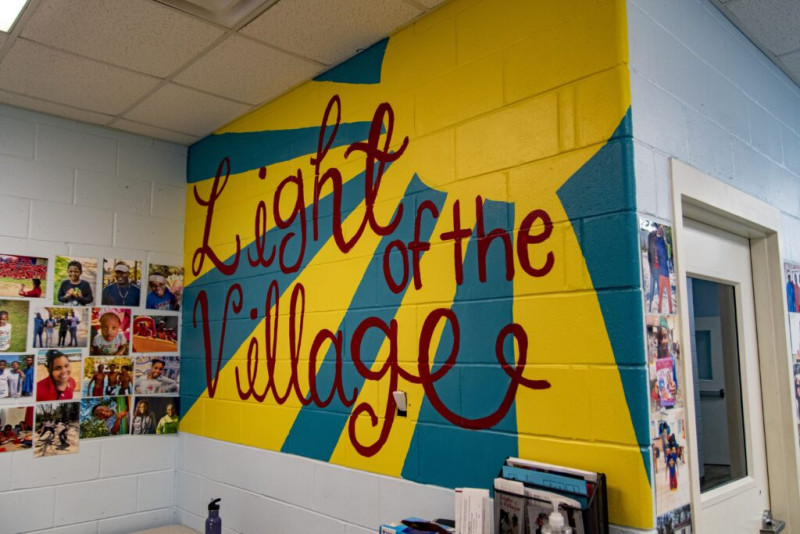
At a recent meeting with local public housing officials, Eads said, some of the neighborhood’s residents were promised public housing vouchers if they moved out of Alabama Village within a certain time frame.
“Some of those people went to get the voucher after that meeting and were told there are no homes currently available,” Eads said. “Typical political response.”
Eads said he hopes policymakers begin to think about these issues through residents’ eyes.
“It’s their home,” Eads said. “They’ve lived here forever. They’ve paid their bills. And you know what? They’re Americans.”
With no local or state-level intervention likely, many of the residents feel that action from the Biden Administration may be the only way to shift the future of Alabama Village. But the villagers also know it’s a long shot.
This Sunday morning, some of them even seemed shocked at even the possibility of federal help in this small, struggling Southern community.
“Do I think the president should do something?” Justin Davis, an Alabama Village resident, repeated the question as he ate his grits and eggs at Light of the Village. He seemed confused. “You mean here? In Mobile?”
He thought for a moment. “Yes, I do,” he replied.
The man looked up from his plate.
“But I don’t think he thinks of us like that.”
Share this article
Disclaimer: The copyright of this article belongs to the original author. Reposting this article is solely for the purpose of information dissemination and does not constitute any investment advice. If there is any infringement, please contact us immediately. We will make corrections or deletions as necessary. Thank you.







